It has been a rich and productive year with the Soil Carbon Coalition.
Our Soil Carbon Challenge continues, with new plots added and baseline plots being re-monitored across North America, and we continue to seek local partners—land managers, watershed groups, conservation districts, and schools—in monitoring soil carbon and other indicators of landscape function. Research facilities can’t possibly keep up with the huge swell of innovation that land managers are trying, nor can current research methods capture the complex (positive or negative) impact of every change we make in our dance with photosynthesis, soil microbiology, and the carbon, water and nutrient cycles. Why not, instead, view the whole landscape as a potential learning opportunity, and engage everyone as participants in the inquiry and creative process?
Peter has our data-collection and mapping app (https://atlasbiowork.com) (UPDATE: this is now soilhealth.app) up and running, and has begun testing it. This is a major advance in ease of reporting (in the field and at the desk) and will enable wider participation in repeatable data and monitoring. He will do a free introductory webinar on Wednesday, October 19, 2016 at 11 am Pacific time (2 pm Eastern).
I have developed over 70 pages of activities, curriculum, and fieldwork instructions to engage students and community members that will soon be formatted so that they can be shared widely in online and print versions, and I have tested these materials and activities with students from Vermont, New Hampshire, Puerto Rico, and Chicago as a basis for developing larger projects in other states. Most exciting for me is that I have been asked to develop a soil-health curriculum (building on materials I’ve been testing) for career-tech FFA agricultural programs at over 350 public high schools in Oklahoma.
We both have done outreach through conferences, teacher trainings, and social media. Public support for—and engagement with—our projects is growing. Students, teachers, farmers and community members are now learning about the power of whole-systems land management and restoration; the microbiology and physics of soil aggregates; principles of soil health; soil’s role in climate resilience and carbon, water, and nutrient cycling; and hands-on monitoring skills for tracking long-term changes in land function.
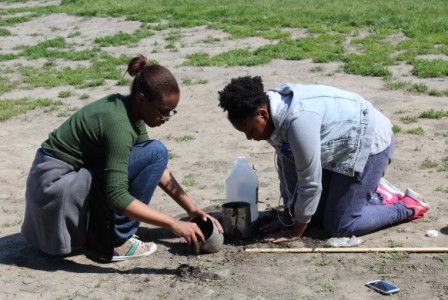 Students testing water infiltration outside a public high school in Chicago
Students testing water infiltration outside a public high school in Chicago
As we travel the country and visit schools and farms in different regions, we are reminded that context is everything, and that intelligence is everywhere. Goals are different, landscapes and weather change, and farming and educational cultures are unique. Wherever we go, we learn, and we get to witness people learning and changing. Because of our travels we often get to cross-pollinate between regions, and witness and respond to both local contexts. We know we are blessed to have this opportunity, and we take it seriously. We are committed to being a responsive organization.
Our goal is to raise $150,000 this year, and we could use your help. We currently have an offer for a $4,000 matching grant from the Vermont Community Foundation’s Sustainable Future Fund. Please consider making a tax deductible to the Soil Carbon Coalition (on the lower right hand menu of this website, or at the bottom if you're on a mobile device) or send a check to:
Soil Carbon Coalition 501 South Street Enterprise, OR 97828 USA
School residencies and learning resources
Hartford High School in Vermont has been my “home base” for developing and testing curriculum and fieldwork protocols, in our "Climate, Water, Soil, and Hope" project. I worked closely with Meghan Wilson and her two biology classes for the entire 2015/2016 school year—meeting regularly to create materials and plan activities, and testing materials and fieldwork exercises in her classes once a week, and will continue to do so this fall. I also helped Rivendell High School in New Hampshire set up three monitoring sites for collecting data, and taught a week-long residency on soil carbon and land function in an environmental studies class at Mascoma High School in New Hampshire.
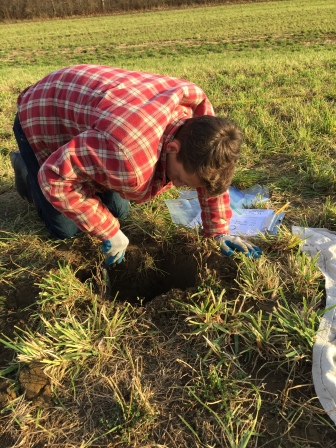 Taking a soil sample in Upper Valley, Vermont
Taking a soil sample in Upper Valley, Vermont
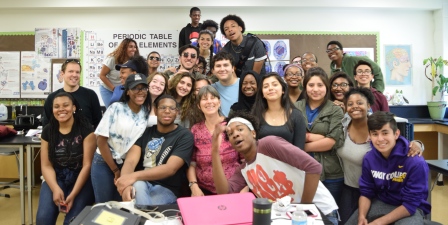 In May I tested our materials during a week-long residency in two advanced biology classes at Ogden, a public high school in Chicago.
In May I tested our materials during a week-long residency in two advanced biology classes at Ogden, a public high school in Chicago.
Learning resources
I have developed and tested several week’s worth of high-school lesson plans and activities, appropriate for science and social studies classes, but which can also be used by anyone wanting to facilitate learning in their own watershed. In addition, I developed a learning progression on soil and water interactions following Next Generation Science Standards (NGSS) standards for K-6 classrooms, which our intern Colby Richardson tested at Thetford Elementary School’s summer program. I am starting to build a team of systems thinkers who can help to design units. Entomologist and agro-ecologist Jon Lundgren and his intern Claire LaCanne at Blue Dasher farm in South Dakota are writing a unit for our curriculum using activities that highlight ecosystem services provided by insects, worms and arachnids, and how to use those services as a land management tool. Keith Berns of Nebraska will write a unit on the principles of choosing cover crops.
350 Schools in Oklahoma!
The USDA Southern Plains Climate Hub and Oklahoma’s statewide career-tech education supervisors have asked me to develop a soil-health curriculum supplement that can be used by teachers in Oklahoma’s career-tech agriculture classes in over 350 public high schools—a program of the Future Farmers of America (FFA). This is an opportunity to adapt our current materials (used mostly by biology teachers) for a more agriculturally oriented audience, many of whom can put the soil health principles into immediate use. As these materials become available in Oklahoma, it seems likely that high school FFA programs in other states will adopt them as well. A group of at least ten agricultural teachers in Nebraska public high schools have already expressed interest. Many schools in New England and California are already on our waiting list for materials and school residencies. In November we will begin professional development programs in Oklahoma.
Advisory Team
I have put together an advisory team of people willing to help develop and edit materials and/or to be available to students as project advisors and career mentors. For example, during the Chicago residency, Jeff Goebel taught the consensus process to students as they were developing a management plan for restoring their schoolyard. Precious Phiri skyped in from Zimbabwe and taught a class on thinking in parts vs. thinking in wholes—showing students how she addressed a multitude of issues in her village by changing grazing patterns. Kent Reeves helped them think about holistic management, and Cat Buxton helped with planning a school composting program. Here are a few of the many good people on our team:
Dr. Kristine Nichols, Soil Microbiologist and Chief Scientist, Rodale Precious Phiri, Former Senior Facilitator at Africa Center for Holistic Management Dr. John Norman, Soil Biogeophysicist University of Wisconsin Dr. Richard Teague, Rangeland Science, Texas A & M Dr. Elaine Ingham, Soil Microbiologist, Soil Food Web Jeff Goebel, Holistic Land Management and Consensus Facilitator Dr. Walter Jehne, Soil Microbiologist and Climate Scientist, Healthy Soils Australia Ray Archuleta, NRCS Soil Health Team Dr. Jeff Mitchell, Plant Sciences, U.C. Davis Dr. Jon Lundgren, Agroecologist and Entomologist Dr. Jane Heinz-Fry, Museum Institute for Teaching Science Keith Berns, cover crop specialist and agricultural teacher, Green Cover Seed Brad Katuna, high school science teacher, Marin County, CA Meghan Wilson, high school science teacher, Hartford, VT
Workshops
During the last 12 months Peter has taught at least 20 workshops on carbon cycling and landscape function—in Chihuahua, California, Oregon, Washington, Montana, Idaho, Kansas, New Mexico, Colorado, Nevada, South Dakota, and probably a few other places! Some of these have been at larger conservation district conferences, but most have been local workshops that function as a way of engaging the community while he is monitoring.
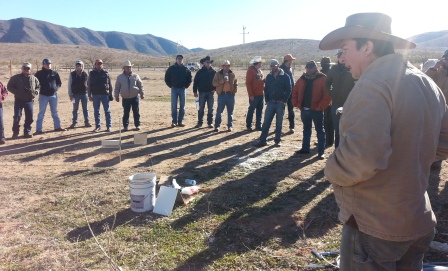 Gerardo Bezanilla (right) explains an infiltration test in Chihuahua, Mexico.
Gerardo Bezanilla (right) explains an infiltration test in Chihuahua, Mexico.
I co-facilitated at a few of Peter’s, and taught a bunch of my own, including these:
- I presented for two days at Gail Fuller’s Field School, and while there I taught three mini-workshops for 70 innovative farmers, ranchers, and policy folks on how to use weekly listening sessions to support each other in moving towards greater soil health leadership. (I define leadership as “anyone who is taking charge of making things go well around them, whether their efforts are recognized or not.”)
- At Vermont SWEEP’S Cultivating Climate Resilience conference I taught a hands-on professional development workshop for teachers.
- During EPSCoR’s Research on Adaptation to Climate Change 2016 weeklong “Streams” training, I taught a two-hour professional development workshop for 20 teachers from Vermont and Puerto Rico—demonstrating indoor and outdoor investigations related to soil carbon’s role in preventing runoff and algae blooms.
My book, The Ecology of Care: Medicine, Agriculture, Money, and the Quiet Power of Human and Microbial Communities came out in February and I am finding that it opens the door to many conversations about soil health and its impact on public health.
Land Listeners
In September we held our first 3-day Land Listeners training here in Vermont. The goal was to equip a team of people with ideas, hands-on skills, and a “community of practice” so that they can bring monitoring and community-learning back to their regions. We had 15 participants, from Ontario, Massachusetts, and Vermont. 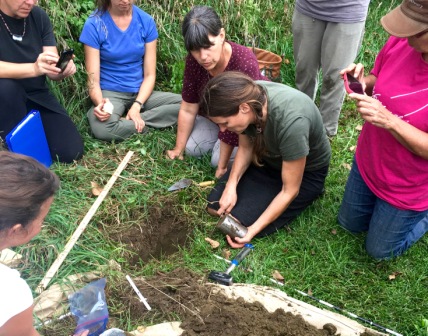 Land Listeners workshop in Thetford
Land Listeners workshop in Thetford
Collaboration and Network Building
We have met with numerous environmental and educational organizations to share ideas. Plans for collaboration are underway with some of them. These organizations include:
Google Earth Engine team California Soil Health Network California Association of Resource Conservation Districts USDA Southern Plains Climate Hub USDA BlueSTEM Agrilearning Center Blue Dasher Farm research and education center Regenerative Agriculture Foundation Kiss the Ground—The Soil Story Sols Vivant, Quebec Healthy Soils Australia South Dakota Soil Health Coalition Conservation districts across the U.S.
Monitoring and AtlasBioWork
This past year, we have added 23 new plots to our Soil Carbon Challenge map and re-monitored 24 of our existing 265 plots. As new data becomes available, more plots will show up online on the map: http://soilcarboncoalition.org/html/changemap.htm. We are currently monitoring for changes in soil carbon, water infiltration rates, bulk density (compaction), and ground cover.
In California, Richard King and Kent Reeves are continuing to help ranchers monitor and plan their grazing to increase soil cover and production as part of the Rancher-to-Rancher project.
Our new data-collection app (see below) and Land Listeners trainings will enable much easier public participation in monitoring for these indicators, as well as any other indicators that communities and land managers want to track, such as earthworm and pollination counts, production per inch of rainfall, aggregate stability, Phospholipid Fatty Acid analysis (PLFA), Haney tests, and general observations of changes in land function and water flows.
A Field Guide to the most powerful and creative planetary force
Our first draft is available here. This contains how-tos for monitoring and sampling, and will be a replacement for our Measuring Soil Carbon Change guide, although that will still be available.
 An illustration from the third chapter "A different science," which explains the differences between problem-solving approaches (left) and an opportunity-based approach (right).
An illustration from the third chapter "A different science," which explains the differences between problem-solving approaches (left) and an opportunity-based approach (right).
AtlasBioWork
The atlasbiowork.com project (Atlas of Biological Work) is a web application and map database designed to facilitate a shared, and shareable, understanding of landscape function. With it, landowners, land managers, citizens, and students can contribute georeferenced data on baselines and changes in soil carbon, water infiltration, productivity per inch of rainfall, and other indicators of landscape function. As we fine-tune the design, the maps will be layerable with Landsat NDVI, streamflow from USGS, and other public and private sources. Peter has spent much of the past year building this amazing tool and public database, and we think it will facilitate the development of a very different kind of science.
The Atlas is based on an open-source framework (wq.io) that is focused on participatory, geolocated, citizen-science data, and works across platforms. Users can collect data on mobile devices while in the field, whether they are offline or online, and upload it to a shared public map. Peter has worked with the wq.io designer to develop a more flexible and inclusive data schema. He has found the learning curves in web development in Javascript, Python, and Django to be both time consuming and productive. With simplicity, flexibility, and broad repeatability as design criteria, atlasbiowork.com can now accommodate a large variety of data types and schemas, and functions as its own API for data sharing and overlaying additional data layers on maps. Atlasbiowork.com is open for testing as of August 2016, and we anticipate its use in schools this fall.
Register here for intro webinar on Oct 19 at 11 am PDT, 2 pm EDT https://attendee.gotowebinar.com/register/5392085664646667267
Peter will be attending the American Geophysical Union meeting in December to seek collaboration from remote sensing people and the International Soil Carbon Network. And if you know anyone who is interested in these domains, and is well-versed in Javascript, Python, Django, Neo4j applications, or the wq framework, please send them our way.
What we learned
There is need for systems-based learning materials: A few organizations have curriculum related to soil health—some of it excellent—but we have not found any that consistently explore a systems or holistic approach to landscape function, or engage students in actual research or land-restoration projects. New NGSS science standards require teachers to use systems-based materials, so teachers who hear about our materials are very excited!
Data collection and uploading can be a challenge. People of all ages are hungry for outdoor learning activities, but due to varying learning styles and attention spans, data collection and uploading can become sloppy. Communities also want to participate in monitoring landscape function, but it takes time to learn monitoring skills and even if data is collected, it often ends up idling in file cabinets, rather than being added to a shared intelligence on how carbon or water cycles function. Our offline-capable mobile app will give people the ability to quickly and easily upload acdcurate geolocation, photos, and observations to a shared map database.
Teaching principles is a far more useful strategy than trying to define “best practices” in land management. The more Peter and I teach and listen, the more we notice this. I wrote an article about what I’ve learned, and spoke about it at Gail Fuller’s. Bottom line: principles are adaptable to unique circumstances, promote shared understandings, and tend to drive innovation. “Best practices” get old fast, can lead to conflict and confusion, and tend to stop innovation.
Participatory learning is necessary when dealing with complexity. People want to do more than address symptoms of poor ecosystem or landscape function, but existing programs, classifications, and incentives often form a discouraging barrier. Because of trends towards online participatory data and learning, people are starting to realize that it's possible and even practical to get involved in understanding and addressing complex root causes by monitoring the impact of their own land management on the surrounding landscape, bodies of water, public health, and local economy over time. We expect our tools will help empower them to do that.
Impact
Professional Development for Teachers
- 37 teachers from New England and Puerto Rico attended one of our four professional development workshops.
Number of Students:
- A total of 146 students from 12 geographic areas learned about soil carbon and whole-systems landscape function (six towns in New England, five towns/cities in Puerto Rico, and Chicago.)
- 40 students in 2 classrooms in Chicago developed a holistic management plan for their schoolyard as part of our week-long residency.
- 39 of 40 students surveyed said they would recommend the program to other schools.
Student Leadership:
- 25 students at Hartford High School took the lead in teaching lab work and field work to the 5 teachers and 12 students who were visiting from Puerto Rico.
- Students from 5 areas collected data and set up 11 new monitoring sites.
- 3 students directed their own teams in monitoring projects.
- 2 students gave oral presentations and a hands-on workshop at an international environmental conference.
- 4 students did continuing internships connected to this project
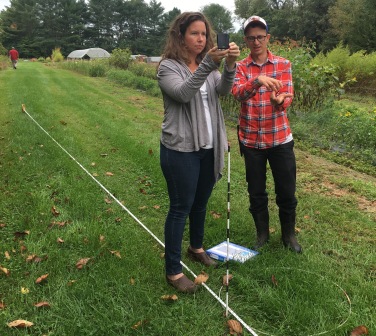 Setting up a transect at Land Listeners workshop in Thetford
Setting up a transect at Land Listeners workshop in Thetford
Outreach
- 25 teachers and staff members at Thetford Elementary School learned about our program and received copies of a sample learning progression for K-7.
- Over 100 participants at the Bionutrient Food Association read about our program.
- 595 participants at four large conferences heard presentations about our school programs.
- We had display booths at the National Association of Conservation Districts, Northeast Organic Farming Association’ VT Conference, Vermont SWEEP’s Cultivating Climate Resilience Summit, and Tufts Restoring Global Water Cycles conference.
Monitoring
- We added 23 new plots to our Soil Carbon Challenge map and re-monitored 24 of our existing 265 plots.
Public Support
We received grants from:
- Vermont Community Foundation
- Wellborn Ecology Fund
- Rudolf Steiner Foundation Social Finance
- San Benito Community Foundation
- New Hampshire Entrepreneur’s Foundation
- 24 people donated a total of $1,400 to Donor’s Choose to bring our program to Chicago.
- 21 people gave us general-purpose donations
- The Byrne Foundation donated $3,000 to Thetford Elementary School in Vermont so they could host our programs.
- Regeneration International has offered to translate our materials into other languages.
What Happens Next?
Peter will continue fine tuning the workings of our atlasbiowork.com mobile app: including creating new forms for uploading different types of data, adapting forms and functions in response to feedback from testers, and working on integrating more map layers. He will continue monitoring and re-monitoring the Soil Carbon Challenge plots. He is creating new illustrations and new chapters for an updated version of our field manual PDF.
He will do a free introductory webinar about atlasbiowork.com on Wednesday, October 19, 2016 at 11 am Pacific time (2 pm Eastern). Use this link to register. https://attendee.gotowebinar.com/register/5392085664646667267
My goal for the next several months is to work on formatting the materials we have developed so that they can be shared online, and to continue to align curriculum with NGSS Standards. I will add profiles of innovative people in soil-related fields, and will continue to develop a network of people working in the field who are willing to meet with students. I will continue to develop a team of non-formal educators who can help lead residencies for the many schools that have requested our programs, and I will hold professional development workshops for teachers in Oklahoma, Vermont, and other states.
The Northeast Organic Farming Association (NOFA) has asked me to be on the team for a multi-year Sustainable Agriculture Research and Education (SARE) grant that will develop materials and webinars to engage farmers in seven northeastern states in learning soil health principles, whole systems landscape function, and field measurements for soil health and soil carbon change. The learning resources we have developed can help form a foundation for NOFA’s materials.
We will continue to teach Land Listeners Workshops where people can gain skills and context for starting monitoring and school-based projects in their own watersheds and conservation districts.
We are actively seeking funding so we can continue this important work. Thank you for supporting our projects. It makes a difference! Warmly, Didi Pershouse
Recent Posts
Archive
Categories
- Events (2)
- policy and framing (22)
- ruminations (3)
Tags
- atlas (2)
Authors
- Peter Donovan (136)
- Didi Pershouse (3)